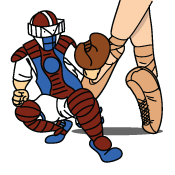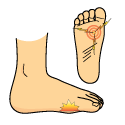What is Sesamoiditis?
Sesamoiditis occurs when the tendons that surround the sesamoid bones in your big toe become irritated and inflamed. The sesamoid bones within the big toe can also be fractured, but this will present with immediate pain, whereas pain caused by Sesamoiditis begins gradually and increases with continued activity. Sesamoiditis is considered a form of Tendonitis.
Causes
Sesamoiditis is most common amongst ballet dancers, baseball catchers and runners. Physical activities that place continued strain on the big toe can lead to Sesamoiditis. Pushing off on the big toe is one of the main causes. Other causes include:
- High arches – runners with high arches place extra stress on the balls of their feet, which can result in Sesamoiditis
- Bony feet – not having a lot of fat to protect your Sesamoid bones can also cause Sesamoiditis to develop
Signs & Symptoms
Signs and symptoms of Sesamoiditis include:
- Pain in the ball of your foot (can become severe if activity is not stopped)
- Possible bruising and/or redness in the affected area
- Difficulty bending the big toe, increased pain when bending the big toe
Treatment Options
Stop Activity – Taking a break from the activity that caused your Sesamoiditis is important if you want to stop the pain and start healing. You can ease back into the activity gradually once your toe starts feeling better.
 RICE – Rest, Ice, Compression & Elevation are effective for treating Sesamoiditis. Resting the foot will help you avoid further pain and aggravation of the tendons. Ice will help manage the pain. Compression and Elevation will work to bring down any internal inflammation you have.
RICE – Rest, Ice, Compression & Elevation are effective for treating Sesamoiditis. Resting the foot will help you avoid further pain and aggravation of the tendons. Ice will help manage the pain. Compression and Elevation will work to bring down any internal inflammation you have.
NSAIDs – Using painkillers (such as Advil and Aleve) can help to control pain and inflammation, but should only be used during times of rest. Using painkillers during physical activity can result in further injury and a longer recovery time.
Steroid Injections – Steroids like cortisone can be injected into the big toe to relieve the pain, but caution should be used. There are several risks associated with cortisone shots, such as bone death, skin discoloration, nerve damage and infection.
Surgery – If conservative treatments have failed to alleviate your symptoms, surgery is an option. This would involve the removal of the sesamoid bone(s) in the affected toe.